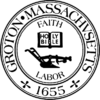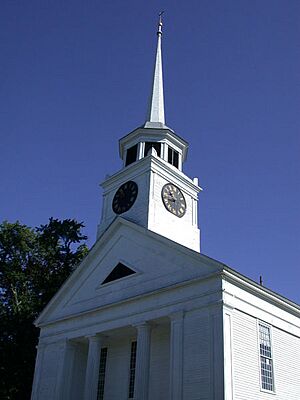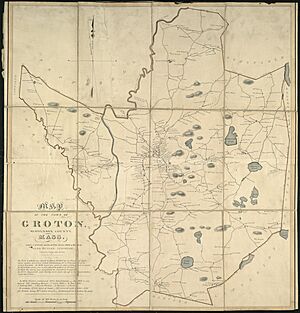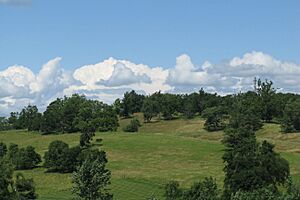Groton, Massachusetts facts for kids
Quick facts for kids
Groton, Massachusetts
|
||
|---|---|---|
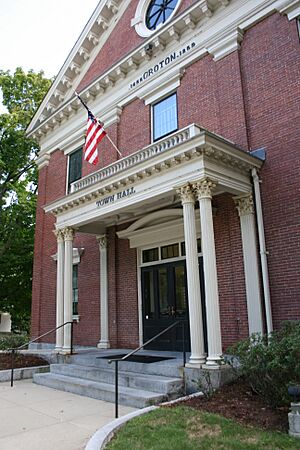
Town Hall
|
||
|
||
| Motto(s):
"All Are Welcome", "Faith, Labor"
|
||
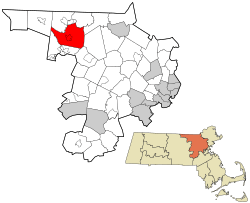
Location in Middlesex County in Massachusetts
|
||
| Country | United States | |
| State | Massachusetts | |
| County | Middlesex | |
| Settled | 1655 | |
| Incorporated | 1655 | |
| Named for | Groton, Suffolk, England | |
| Government | ||
| • Type | Open town meeting | |
| Area | ||
| • Total | 33.7 sq mi (87.3 km2) | |
| • Land | 32.8 sq mi (84.9 km2) | |
| • Water | 0.9 sq mi (2.4 km2) | |
| Elevation | 320 ft (98 m) | |
| Population
(2020)
|
||
| • Total | 11,315 | |
| • Density | 335.8/sq mi (129.61/km2) | |
| Time zone | UTC−5 (Eastern) | |
| • Summer (DST) | UTC−4 (Eastern) | |
| ZIP Code |
01450
|
|
| Area codes | 351/978 | |
| FIPS code | 25-27480 | |
| GNIS feature ID | 0619399 | |
Groton is a town in northwestern Middlesex County, Massachusetts, United States. It is part of the larger Greater Boston area. In 2020, about 11,315 people lived here.
Groton is a town where many people live and work in nearby Boston. Many residents have jobs in technology. You can travel to Boston from Groton using highways like Route 2 or the MBTA Fitchburg Line train.
The town has a long and interesting history. It was a site of battles during King Philip's War and Queen Anne's War. People from Groton also played important roles in the American Revolutionary War. For example, William Prescott was a commander at the Battle of Bunker Hill.
Groton is home to two special boarding schools that prepare students for college: Lawrence Academy at Groton, founded in 1792, and Groton School, founded in 1884. Famous people from Groton include former U.S. Secretary of State John Kerry and sports journalists Peter Gammons and Dan Shaughnessy.
Contents
History of Groton
Early Frontier Settlement
For thousands of years, the land around Groton was home to different groups of indigenous peoples. They lived near the rivers, using them for daily life, fishing, and travel. The Nipmuc and Nashaway tribes, who spoke Algonquian languages, created trails that connected this area to Massachusetts Bay.
European settlers arrived when John Tinker set up a trading post with the Nashaway tribe. This was where Nod Brook met the Nashua River. The Nashaway called the area Petapawag, which meant "swampy land." More Europeans moved here because the land was good for fishing and farming.
In 1655, Groton was officially settled and became a town. It was named after Groton in Suffolk, England. This was the hometown of Deane Winthrop's father, John Winthrop, who was the governor of Massachusetts. The area called The Plantation of Groton was very large. It included all of today's Groton and Ayer, most of Pepperell and Shirley, and parts of other towns in Massachusetts and New Hampshire.
During King Philip's War, a conflict between English colonists and Native Americans, Groton was attacked. On March 13, 1676, Native Americans raided the town and burned almost all the buildings. Only four strong garrisons (fortified houses) remained. Survivors fled to nearby towns like Concord. Two years later, many returned to rebuild. The town became very protected, with 91 men in its garrison by 1692.
In 1694, during King William's War, Abenaki warriors attacked Groton again. Lydia Longley and two of her siblings were taken captive, while the rest of their family was killed. Lydia was taken to Montreal, where she was later freed. She became Catholic and joined a religious order.
In 1704, during Queen Anne's War, another Abenaki raiding party kidnapped Matthias Farnsworth III. He was also taken to Montreal.
In 1707, Abenaki warriors captured three children from the Tarbell family. These children were cousins to the Longleys. They were taken to a Mohawk village near Montreal. The two boys, John and Zachariah, were adopted by Mohawk families and became part of their culture. They later married daughters of chiefs and became respected chiefs themselves. Their older sister, Sarah, was freed by a French family and became Catholic. She joined the same religious order as Lydia Longley. Today, some Mohawk people in Canada still have the Tarbell last name.
Revolutionary Era and Early Republic
The people of Groton strongly supported the Patriot cause during the American Revolutionary War. After the Boston Tea Party, Groton thanked Boston for its brave actions. The town also decided to stop buying tea until taxes on it were removed.
In 1775, local minutemen (citizen soldiers) gathered in front of the First Parish Church. They then marched to the Battles of Lexington and Concord. Groton sent 101 men, but they arrived too late to fight. William Prescott, who led the American forces at the Battle of Bunker Hill, was born in Groton. Groton lost 10 or 12 men in that battle, more than any other town.
However, this strong patriotic feeling did not last for everyone. Many Groton residents sided with the rebels during Shays' Rebellion. Job Shattuck, a former army officer and a large landowner in Groton, led an early tax protest in 1782. He was fined but rose up again in 1786. He led a group that closed down the Middlesex County Courthouse. He was later captured and sentenced to death, but the governor pardoned him.
Groton's economy grew strong early on. This was helped by its location near the Nashua and Squannacook Rivers. By 1790, it was the second-largest town in Middlesex County, with 1,840 people. Farming was the main business, but industries also came to town. In the early 1800s, a paper mill opened in West Groton. In 1828, a large soapstone quarry was found. Groton eventually had the biggest soapstone factory in the country, selling products as far away as China.
South Groton, now Ayer, got connected to railroad lines in the 1840s. One of these lines is still used today as the MBTA Fitchburg Line. This train connects Groton to Boston.
African-Americans have lived in Groton since at least the 1750s. Primus Lew, whose son Barzillai Lew was an early African-American soldier, bought a farm here. Another African-American man from Groton fought at Lexington and Concord. Some historians believe "a negro man belonging to Groton" fired the shot that killed British general John Pitcairn at the Battle of Bunker Hill.
Starting in the 1840s, Catholic immigrants, mostly Irish and some French Canadians, began moving to the area. St. Mary's Catholic Church was built in 1858 for Catholic residents. Ayer separated from Groton in 1871. In 1904, a local private school gave Sacred Heart Church to the Catholics who remained in Groton.
Economic Changes and Social Issues
Groton's economy slowed down in the second half of the 1800s. The soapstone quarry closed in 1868. The town's population almost halved from 1870 to 1880. This was mostly because Ayer became its own town in 1871, taking about 1,600 residents with it.
In the 19th and early 20th centuries, most of Groton's population was white and Christian. There has been discussion about whether it was a "sundown town" – a place where non-white people were not welcome after dark. The town became a center for the Ku Klux Klan in Massachusetts in the 1920s. This group mainly showed prejudice against Catholics and immigrants, as well as racial minorities.
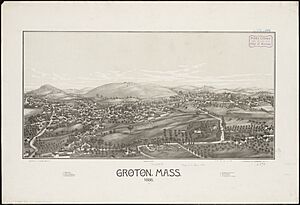
The Klan held a rally in Groton in September 1924. In 1925, a cross was burned on Gibbet Hill. In October 1926, a group of 400 Klansmen were meeting when they were shot at by about 100 people who opposed them. Police reported over 100 gunshots, but no one was hurt. In 1927, the local Klan group supported candidates for town elections, and some of them won. The Klan's influence in the area seemed to fade by 1931.
In 2020, Groton's town meeting voted to speak out against racial prejudice and support equality. This was done to acknowledge past events and support modern social justice movements.
Economic Revival
Starting in the 1950s, Groton's economy began to grow again. This happened as Boston's high-tech industry expanded along the Route 128 highway. Even though Groton is not directly on Route 128, it became part of Boston's growing economic area.
The town attracted many professional workers, and its population grew quickly. It has almost quadrupled since 1950. A group led by Marion Stoddart helped clean up the Nashua River. Before, the river was so polluted that animals could sometimes walk across the sludge.
In 2021, Groton's average income per person was among the highest in Massachusetts. Many residents are well-educated and have high-paying jobs. Town leaders describe Groton as a "bedroom community" and a "relatively affluent town."
In the 21st century, Groton has worked to keep its rural feel and slow down population growth. As of 2017, 42% of the town's land is protected from development. In the 2000s, Steven Webber bought a large farm to prevent houses from being built there. The town meeting gave him a standing ovation for this.
Groton wants to welcome tourists but prefers a steady flow rather than a huge crowd. In 2017, the town adopted the motto "All Are Welcome." They placed six stones with this motto on the main roads leading into town.
Even with slower population growth, town services have improved. Gibbet Hill now has a restaurant that uses fresh, local food. In 2017, the largest Shirdi Sai Baba temple in the country opened in Groton. It cost about $11 million to build.
The Groton Hill Music Center opened in 2022. It has a large concert hall and a smaller one, a professional orchestra, and a community music school. This center was a gift from an anonymous donor, later revealed to be Sterilite owner Albert Stone. The Groton-Dunstable Regional School District is building a new elementary school, set to open in 2024.
Geography of Groton
Groton covers about 33.7 square miles (87.3 km²). Most of this is land, with a small part being water. Groton is the largest town in Middlesex County by area. The town has rivers like the Nashua River, Squannacook River, and Merrimack River. The center of town has a large hill called Gibbet Hill, and there are other hills throughout the area.
Several state roads pass through Groton, including Route 40, Route 111, Route 119, and Route 225. Groton shares borders with towns like Pepperell, Dunstable, Westford, and Ayer.
Climate in Groton
Groton has a humid continental climate, which means it has warm summers and cold winters. Temperatures in Groton are usually below 50°F (10°C) for about 195 days each year. The town gets about 45.7 inches (116 cm) of rain each year, which is a lot for the United States. Snow covers the ground for about 68 days a year.
Demographics
| Historical population | ||
|---|---|---|
| Year | Pop. | ±% |
| 1676 | 300 | — |
| 1765 | 1,408 | +369.3% |
| 1776 | 1,639 | +16.4% |
| 1790 | 1,840 | +12.3% |
| 1800 | 1,802 | −2.1% |
| 1810 | 1,886 | +4.7% |
| 1820 | 1,897 | +0.6% |
| 1830 | 1,925 | +1.5% |
| 1840 | 2,139 | +11.1% |
| 1850 | 2,515 | +17.6% |
| 1860 | 3,193 | +27.0% |
| 1870 | 3,584 | +12.2% |
| 1880 | 1,862 | −48.0% |
| 1890 | 2,057 | +10.5% |
| 1900 | 2,052 | −0.2% |
| 1910 | 2,155 | +5.0% |
| 1920 | 2,185 | +1.4% |
| 1930 | 2,434 | +11.4% |
| 1940 | 2,550 | +4.8% |
| 1950 | 2,889 | +13.3% |
| 1960 | 3,904 | +35.1% |
| 1970 | 5,109 | +30.9% |
| 1980 | 6,154 | +20.5% |
| 1990 | 7,511 | +22.1% |
| 2000 | 9,547 | +27.1% |
| 2010 | 10,646 | +11.5% |
| 2020 | 11,315 | +6.3% |
| 2022* | 11,162 | −1.4% |
| * = population estimate. Source: United States Census records and Population Estimates Program data. |
||
In 2000, Groton had 9,547 people living in 3,268 households. About 46.8% of households had children under 18. Most households (70.0%) were married couples. The average household had 2.90 people.
The median age in Groton was 36 years old. About 32.6% of the population was under 18. For every 100 females, there were about 98 males.
The median income for a household in Groton was $118,041. For families, it was $136,653. The average income per person was $44,756. Only a small percentage of families (1.1%) and people (1.8%) lived below the poverty line.
Sports in Groton
Groton hosts the National Shepley Hill Horse Trials every year. This is a competition for horse riding. The Groton-Dunstable Crusaders are the high school sports teams that compete in the town.
Education in Groton
Public Schools
District Schools
- Boutwell School
- Florence Roche Elementary School
- Groton-Dunstable Regional Middle School
- Groton-Dunstable Regional High School
Other Public Schools
- Nashoba Valley Technical High School, a public technical high school in Westford.
Private Schools
- Groton Community School
- Lawrence Academy (started in 1793 as Groton Academy)
- Groton School (started in 1884)
Some older schools in Groton have closed. These include Prescott Elementary School (1927–2008) and the Catholic Country Day School of the Holy Union (1949–2017). The old Groton High School building is now listed on the National Register of Historic Places.
Points of Interest in Groton
- Groton Historical Society & Museum
- Groton Public Library
- Groton Hill Music Center
- Gibbet Hill Castle
- The Groton Inn
- Kalliroscope Gallery
- Autumn Hills Orchard
- Grotonwood Camp and Conference Center
- Groton School
- Lawrence Academy
Buildings and Structures
- Gov. George S. Boutwell House
- Indian Hill House
- Groton Inn, which burned down in 2011 but was rebuilt and reopened in 2018.
Conservation Land
Over 30% of the land in Groton is protected open space. Most of this land is open to the public. Groton also has more than 100 miles of trails. You can walk and bike on many of these trails. Some areas are also available for hunting or camping.
The trails are made and kept up by the Groton Trail Committee. The land is owned and managed by groups like the Groton Conservation Trust and the Massachusetts Audubon Society.
Notable People from Groton
Military
- Barzillai Lew, an early African-American soldier during the American Revolution.
- Oliver Prescott, a doctor and general during the Revolutionary War. He helped start Lawrence Academy.
- William Prescott, who led American forces at the Battle of Bunker Hill.
Business
- Adolphus W. Green, who founded the company Nabisco.
- Abbott Lawrence, a businessman who founded Lawrence, Massachusetts.
- Amos Lawrence, a merchant and giver to charity.
- Amos Adams Lawrence, who fought against slavery and helped start the University of Kansas.
- Samuel Lawrence, a revolutionary who helped start Lawrence Academy.
- Simon Willard, an early colonist and fur trader.
Religion
- Samuel Dana, a religious leader.
- Lucius Edwin Smith, a journalist and religious scholar.
Education
- Charles William Bardeen, an educator and publisher.
- Edward Saxton Payson, a writer and translator who supported the Esperanto language.
- Endicott Peabody, who founded Groton School.
- L. Hugh Sackett, an archaeologist.
- Samuel Willard, who was the acting president of Harvard University from 1701 to 1707.
- Frank Bigelow Tarbell, a professor of art history.
Journalism
- Margaret Fuller, a journalist, critic, and activist for women's rights.
- Peter Gammons, a sportswriter.
- Steve Kornacki, a political writer and TV host.
- Dan Shaughnessy, a sportswriter and radio host.
Art, Sports, and Entertainment
- Andy Anderson, a rowing coach who is in the National Rowing Hall of Fame.
- Bill Camp, an actor.
- J. Geils, who founded The J. Geils Band.
- Kevin Kastning, a musician and inventor of musical instruments.
- Paul Matisse, an artist and inventor.
- Shabazz Napier, a basketball player.
- Lawrence M. Noble, a hockey player.
- Shelley Olds, a professional cyclist who competed in the 2012 Summer Olympics.
- Otto Piene, an artist.
- Edmund C. Tarbell, an artist.
- Paul Zukauskas, a football coach.
Other Notable People
- Elizabeth Knapp, known as the "Witch of Groton."
- Lydia Longley, known as "The First American Nun."
- Job Shattuck, a leader during Shays' Rebellion.
See also
 In Spanish: Groton (Massachusetts) para niños
In Spanish: Groton (Massachusetts) para niños


